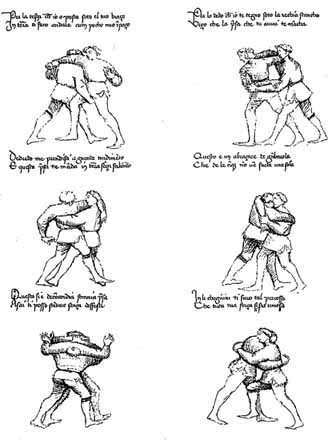The Life of an Italian Knight
Feltrino, Boiardo's grandfather, was active as guerriero with humanistic tendencies. He took part in the fights after Giangaleazzo Viscontis death in Milan (1403), in the uprising against the tyrant Ottobuono Terzo in Reggio together with Muzio Attendola and in the action to free Muzio Attendola in 1416 in Naples.The Boiardi were traditionally citizens of Reggio and feudal lords of Rubiera. Possibly this romantic and adventurous phase in the life of the grandfather led Matteo Maria Boiardo to be enthusiastic about the life of knights and fighters. Much later he developéd the romantic chivalry in his Orlando Innamorato, which became his main work. Feltrino and his interaction with Niccolo included travel to 'exotic' places.
Feltrino is recorded to have at least been with him on two pilgrimages (one to Jerusalem, where Feltrino is knighted). The location Scandiano, homeplace of the Boiardo family, is recorded as Jewish friendly, likely this is not without influence on the early studies of oriental languages by the grandson MM Boiardo and indirectly also on Matteo's younger cousin and the second very talented grandson of Feltrino, the famous Giovanni Pico da Mirandola, who became reknown as the first Christian kabbalist.
Most likely colorful accounts of travels also impressed upon his grandson, Matteo Maria, who was often at Count Feltrino's household. MM Boiardo's exotic locales for his romantic epic is often noted.
Time Line of Feltrino
- 1403: Feltrino is active in the fights in Milan.
- 1407 - 1409: active against Ottobuono Terzo
- April 6-July 6, 1412 Marquis Niccolo D'Este did a pilgrimage to Jerusalem, visiting Venice, Ionian Islands, Pola, Corfu, Rhodes, Cyprus, and Syria Sometime between May 15-19, at Mass at the Holy
Sepulcher, Niccolo dubbed five knights of his retinue, including Feltrino Boiardo.
- In 1413, the Marquis and a party that included Feltrino went to St. Anthony at Vienne and also met the King of France in Paris. Marchese Manfredo del Carretto di Cera captured them in Piedmont and offered to sell them to the Duke of Milan, as Milan had not yet recovered Parma from Niccolo D'Este's military seizure in 1409. The Count of Savoy forced di Cera to surrender the captives and beheaded di Cera.
- 1416: active to free Muzio Attendola in Naples.
- In 1423-Feltrino ceded Rubiera to Niccolo and received Scandiano instead with other smaller townlets and the title Count. Feltrino married Guidduccia, daughter of the Count Gherarado da Goreggio, with two sons resulting, Giovanni and Guilulio Ascanio, also one daughter, Giulia, the later mother of Giovanni Pico de Mirandola.
- Giovanni married Lucia Strozzi, the sister of the poet Tito Vespasiano Strozzi, and had from her one son, Maria Matteo and four daughters.
- Between 1429-36, another mention of Feltrino describes him as participating within the circle of informal lectures. The circle of young and older men surrounding the young heir to Ferrara, 22-year-old Leonello (born 1407) and private tutor Guarino Veronise, a scholar of Greek who later became the Chair of Greek and Latin Letters at the local Studio, the academic university at Ferarra.
- In 1452, after Borso was raised to Duke of Modena and Reggio, Count of Rovigo by the new Holy Roman Emporer Frederick, he made a triumphal tour of his regions. The city of Reggio paid homage by having the governor of the city, the entire garrison in battle array and thousands of children with flowers at the gate of the city. Borso approached with his younger brother Ercole and Feltrino Boiardo preceding them both, bearing the sword of Reggio.
- 1456: Feltrino dies.
Additional material
Note: Roberto Damiani, Italian expert for condottieri mentioned in private communication, that he reflects Feltrino Boiardo as courtier, not as condottieri. Likely Boiardo had his role near to Niccolo d'Este, not as general in the field (which was taken by Niccolo d'Este himself occasionally in his younger time). Likely dominated the militarical aspects till Niccolo's marriage to Parisina, when cultural aspects started to win in influence. The cultural aspects started to dominate with 1429, when Guarino da Verona was invited to teach Leonello (which ended in the education of the whole court and the expansion of the small university from 30 to 300 students in Leonello's time. Ferrara's general role became the "neutral zone" between the fighting states Milan-Venice and the place, at which peace was concluded (which was then broken soon regularely). For the earlier militarical dominance in Ferrara see below:Fighting technique in Ferrara under Niccolo III, around the time when Feltrino was young:
Fiore dei Liberi was born in Northern Italy in the middle of the 14th century, and spent 40 years learning techniques of combat from many masters and at great expense. He fought in the battles and duels of his time, and eventually became an instructor himself. He trained many knights and squires for combat in tournament, war and duel, and in 1400 was appointed by the Marquis of Ferrara as the trainer to his personal knightly household with duties as a military advisor. It was the Marquis, Niccolo D’Este, for whom Fiore wrote down all he knew so that his art would not be lost to those who came after.Fiore’s manual, the Fior di Battaglia (Flos Duellatorum in Latin) includes wrestling, knife attack and defense, one and two handed sword, pollaxe spear, and mounted combat both armored and unarmored. It is a complete, coherent and brutally effective system of self defense that can apply to any situation armed or unarmed. He distilled the art down to its essentials, and created an integrated, sequential and self-referential system that is easy to teach and to learn (source).
See also:
 Fiore Dei Liberi 1410
Fiore Dei Liberi 1410